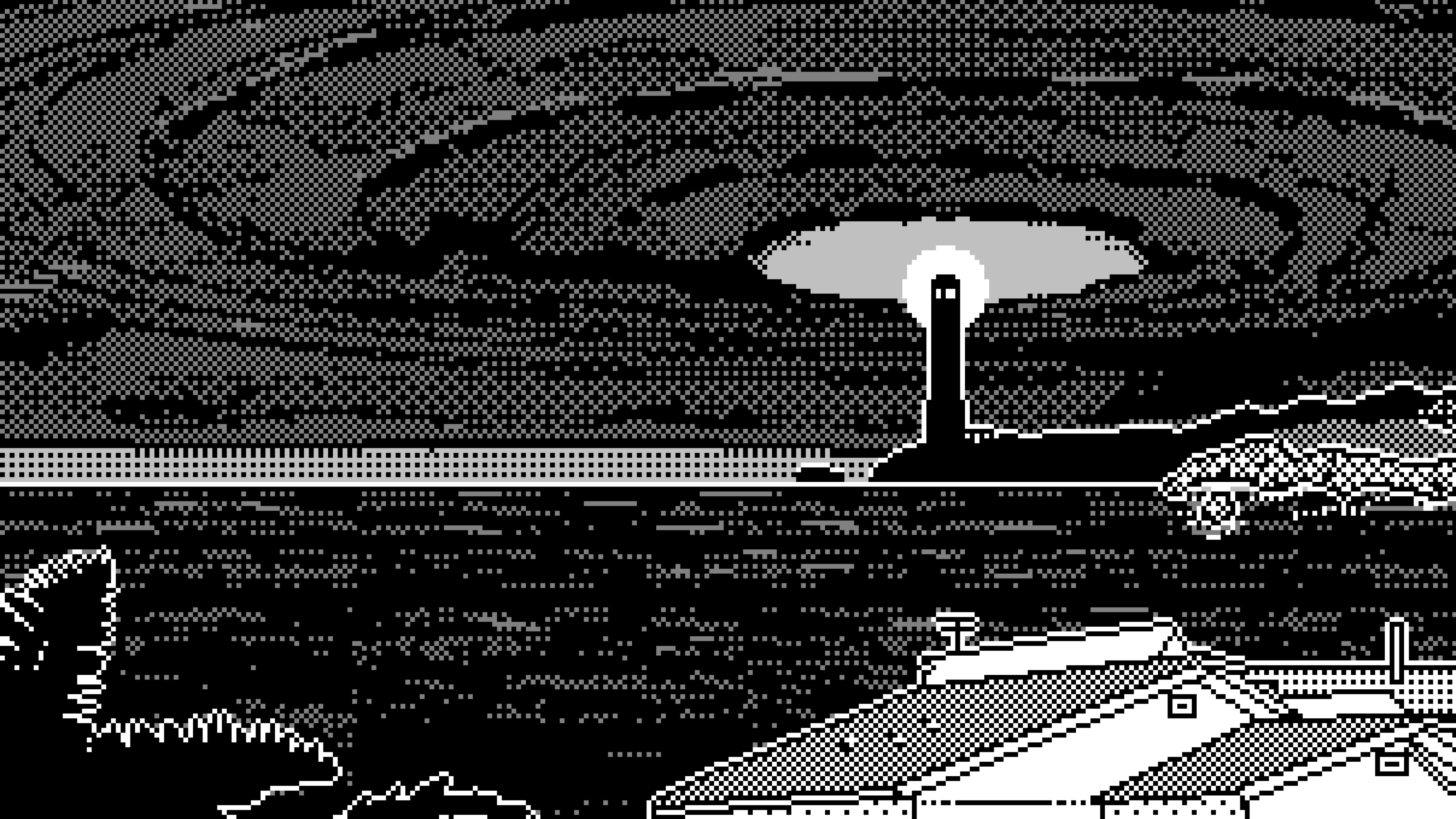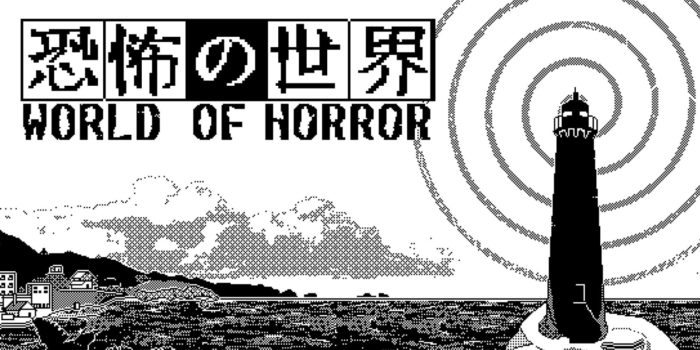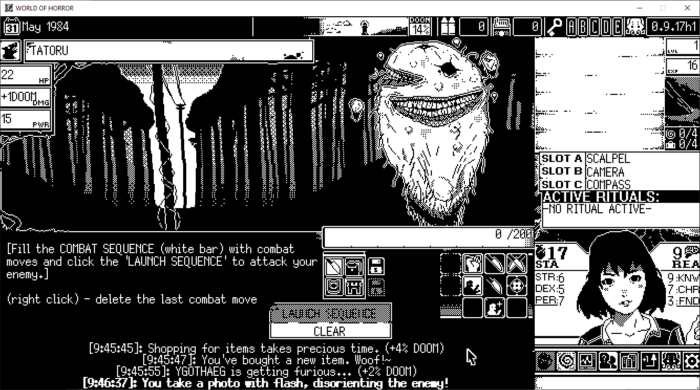
World of Horror Review
Japanese Terror That Never Ends
What do you get when you cross Junji Ito’s artwork, Lovecraft’s Cthulhu Mythos, Dark Gods, and Japanese demons, all gathered in a Japanese town for you to explore?

You get World of Horror. A primarily text-based, turn-based Roguelike game developed by Panstasz and published by both Ysbryd Games and PLAYISM. In the game, you take on the role of a character in a Japanese town overtaken by the supernatural, cults, demons, ghosts, and more, and you have to figure out various mysteries and how they all tie in together. All the while, dark clouds loom in the distance, and a Lighthouse beckons for you to unlock and explore.
Currently, the game is available on PS5, PS4, Nintendo Switch, and PC via Steam or GoG, costing around $20. Thankfully, the game also doesn’t require a massive amount of resources to play, as it only requires 1GB of RAM and 500 MB of Hard Drive space. It can run on practically any processor or graphics card, provided it was made in the last 10 years. So even low-end PCs should be able to run it with no problem.
So, enough about the specs. What is the game about, and what is its story and gameplay like? For this review, I will break it down into several components to explain the game in depth and let you decide if it interests you. I’ll also keep this review as spoiler-free as possible, as the purpose of a review isn’t to explain the entire thing but to give you an overview of what the game is like so you can make an informed opinion yourself.
However, keeping things spoiler-free will be relatively easy, as I’ll explain below.
Story
World of Horror isn’t a narrative-driven game in the traditional sense. There’s a lot of reading to do, and every decision you make changes the story, but there’s no full, singular story that unfolds for you.
Instead, you see story snippets broken up into small segments or “investigations” that you must do to further the plot of that current run. There is an overarching story, but it’s more of a backdrop and a reason for why your character is in this small town investigating cosmic horror entities and gathering evidence about the supernatural. The story for that is that you’re there to investigate because you’re curious.
From there, all the story segments are randomized, including items, characters you come across, and even enemy encounters.
There are several modes of play, but the primary one has you taking on the role of a high-school student who has to investigate five different stories, earn different keys, and unlock whatever is at the top of the lighthouse. I won’t spoil that ending for you. If you’re a fan of Lovecraftian Horror, then you’ll really be eager to see this ending.
Outside of the main play mode, you can play different characters, which I’ll get into in the next part. Other than cosmetics, however, none of the characters have unique stories, and all play the same, just with different stats.
Gameplay
The gameplay is simple, and it’s easy to get the hang of once you’ve completed the tutorial several times (which takes 15-20 minutes). It might look complicated at first because of all the reading, the different dialogue and action choices, and the UI setup, but once you learn it, it becomes second nature.
In fact, you don’t need to be hyper-aware of the game. Everything is done through menus and through choices that you make. There’s no fast-paced combat, quick-time button presses, or button-mashing attacks. If you wanted, you could read what’s presented and think things through. It’s like a choose-your-own-adventure book.

The UI is where almost all of the action takes place. It’s designed to look like a late-80s, early-90s Japanese computer (think Apple II for an American comparison), so it’s all in 8 bits. You click on elements of the UI to choose different menus, such as your map, inventory, character build, level progression, status, and more. You can also use the UI to select where to investigate, who to talk to, or any number of different actions. You can also change the UI color if black-and-white isn’t your thing.
Combat is also simplistic. It’s turn-based, where the monsters you’re fighting are in front of you. You get three options menus to choose your actions and an AP (Attack Point) pool that’s spent depending on the action you choose, your combat stats, and the weapon you have. You can be offensive with light attacks, heavy attacks, order allies to attack, or defensive with blocking, dodging, etc. There are even special actions that you can perform, such as prayer or special story actions that show up depending on what story segment you’re on and the choices you make.

At its core, “World of Horror” is an RPG Roguelike with some Roguelight mechanics thrown in. The Roguelight parts are mainly in that you unlock small things here and there, and you can customize a game run to either benefit you more (for an easier time) or punish yourself (for a more challenging time).
The Roguelike mechanics are obvious. As stated, each run is different, and there’s no guarantee of success. Some runs can start amazingly but go downhill fast, even if you’ve made all the right choices. It helps that most story segments are 30-40 minutes long, and you can complete the main game mode in around 2-3 hours, so you don’t feel like you’ve wasted your time when you lose. Especially since most story segments have 3 or 4 endings, depending on your choices
While there are RPG mechanics in that each character you play has different builds and perks for different gameplay styles, and you can customize your character with stats, feats, spells, items, and more, those are also entirely randomized depending on your playthrough. You’re not guaranteed to get the feat you want when you level, and some stats might even be diminished through gameplay. In fact, it’s not uncommon to make a choice that’ll debilitate you. Even your magic spells are randomized, and there’s no guarantee they’ll even help you.
But that’s where the fun of it comes from. With each run being unique, you never know what combination you’ll get, and once you’ve seen the game’s ending several times, the fun mostly comes in seeing what narrative choices you make in a run will do and what kind of horror you can find, or finding a new monster to come across and seeing how scary it is. Thankfully, the game keeps track of what stories you’ve done, what endings you have, and what monsters you’ve fought, so you’ll know whether you’ve seen it all or not.
Game Length
Considering how much is crammed into the game and how the gameplay loop has you playing, reading, making choices, dying or surviving, and then doing it all again, you can easily sink 20 to 30 hours into the game without even seeing half of what’s available.
That’s what makes it a fun pick-up-and-play game for a fun, cozy night of scary fun. Some players have sunk hundreds of hours into the game, developing punishing runs to see if they’d survive all the way to the end, while there are players who put in the same amount of time but set their games up to be easier so that they enjoy a good story to send chills up their spines.
You should expect around 20-30 hours for casual play to get the most out of the game. Though it’s such a small download, you can keep it on your console/computer without fear of wasting space. Especially if it’s a game you want to revisit from time to time when you have a few hours to kill at night and have exhausted all other horror-based entertainment.
Plus, for those who like to play on PC, there is a small modding community that has created content. Content includes additional story segments and their choices, and additional characters, art, music, and gameplay choices, all of which can add to your total playtime.
Horrors And Scare Factor
With all that said, is the game scary?
Yes. Yes, it is. The visuals themselves are the most striking aspect of the game, with many backgrounds, characters, monsters, and animations having this sort of horrendous, visceral sharpness that makes one want to recoil from the screen. You’ll find cultists wearing masks and robes, with their eyes hidden in shadows. You’ll discover grotesque monsters wielding scissors who have cut their faces wide open into painful grins as they bleed and tentacles that writhe and squirm, appearing out of thin air.
You’ll even find yourself lost in various settings as well. From old abandoned schools full of urban legends that drag children into the pits of hell to hospitals with gibbering, wide-eyed nurses murmuring incantations and horrific hymns, to even accidentally stepping into icy worlds with twin moons that you wander thousands of years through before returning to reality changed and maddened. Even your apartment isn’t safe with neighbors spying on you every chance they get.
Characters, beings, monsters, and more show up and leave just as quickly, and certain scenes might seem normal until you make certain choices and decisions that change them from the mundane to the horrifying.

All of this is relentless, too. A certain aura of wrongness pervades every area you go to, and it almost feels like there’s no real safe space to return to. Danger lurks around every corner, and that’s half the fun because certain parts will come up that seem pretty benign but then aren’t anymore, and you realize the danger you’re in. Sometimes, every choice you make is wrong, and you’re left to pray to get out of fights or story parts unscathed.
So, it is scary in all the right ways.
Downsides
With all that said, are there any downsides?
A few. The biggest downside is how the game saves data. It wasn’t until the final 1.0 release on Consoles that you could save your game, being completely unavailable in earlier builds. Even now, it still screws up a lot of times.
The biggest issue with saving your game is that there aren’t any save slots. So you can’t save multiple gameplays and go back to one you want to work on, or save scum if you get a result you don’t like. It’s incredibly finicky, too, as it’ll often forget to save choices you’ve made in the past, and sometimes it’ll even corrupt your save… and not in a fun way.
When it comes to saving, your best bet is to save only when you need to. Runs can be completed in an hour or two, so only do a run if you have the time; otherwise, cross your fingers.
Another downside is the roguelike nature of the game. While it makes playing fascinating, since your adventures can go in many different directions, it makes trying to 100% finish the game tedious, as you’ll be playing scenarios and stories you’ve already done just to see everything. Plus, nothing is more annoying than getting close to the end of your investigations and nearing the top of the lighthouse, only for it to quickly spiral out of your control. The randomness sometimes works against you.
But if you don’t mind that, like that sort of gameplay style, and enjoy powering through it, then that last part might not be a downside at all.
Unfortunately, there is one last downside that might turn some people off the game altogether. Since the game left Early Access and was released on PlayStation and Nintendo Switch, there has been no major update in two years. Some parts of the game still feel unfinished, and the development blog stated that there would be many updates, refinements, and QoL upgrades that haven’t been acknowledged since its last content patch.
This is a massive turnoff for many people and shows that the developer doesn’t intend to return to the game. As of this writing, the developer isn’t working on another project, so many players feel the game has been abandoned. However, for what you get now, there is still a lot of content available for the price you pay, so it all depends on whether you feel comfortable purchasing a game that is still partly unfinished.
Overall Thoughts
“World of Horror” is an amazing game and an unforgettable horror story to boot. As stated at the start, if you’re a fan of Lovecraft and Cosmic Horror, Junji Ito, or Japanese horror in general, you will love this game for its atmosphere, sound design, and musical score. Its retro graphics lend a certain charm that evokes the 80s in a way that only analog horror can itch, and the 8-bit graphics and animation are smooth and evocative.
If you like to read a lot, too, or take games slow and at your own pace, then that works more in its favor. The best way to experience the game is to turn off the lights, sit under a blanket, keep a drink and some snacks close by, and try not to look into the shadows between plays.
Those looking for more action-packed thrills should still check it out, but keep in mind the type of game that it is. Otherwise, it’s a solid 8/10. It’s simple, fun, and deliciously scary, and the casual gameplay loop makes it a fun, bite-sized treat to play before bed, especially if you want to experience nightmares.
As stated above, it is for Nintendo Switch, PlayStation, and PC, and you can find the PC release on both Steam, and GoG (Good Ol’ Games).
Thank you for reading, and if you choose to delve into this terrifying world, sweet dreams.

